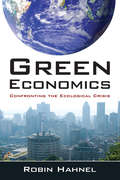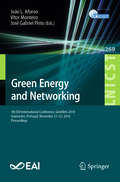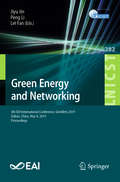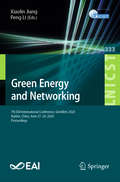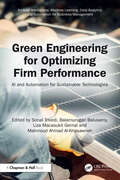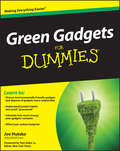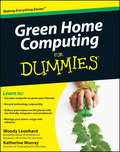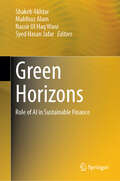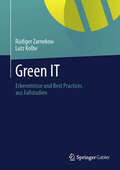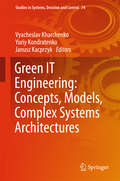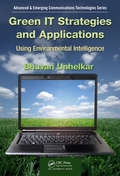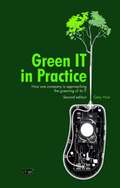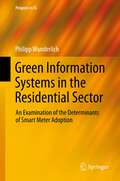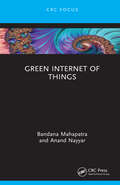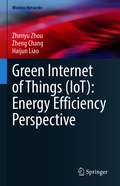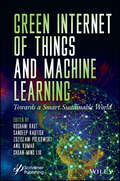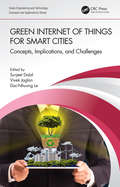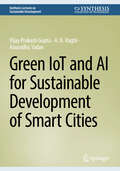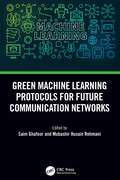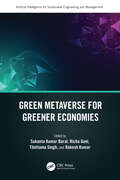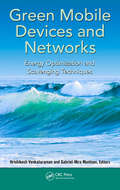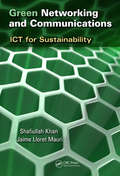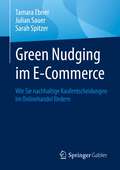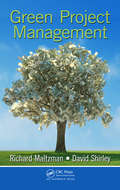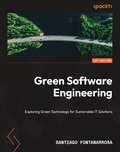- Table View
- List View
Green Economics: Confronting the Ecological Crisis
by Robin HahnelThis book's pluralistic, non-dogmatic, and committed investigation of the values of ecological sustainability, economic justice, and human dignity provides balanced analysis of environmental problems and their potential solutions.
Green Energy and Networking: 5th EAI International Conference, GreeNets 2018, Guimarães, Portugal, November 21–23, 2018, Proceedings (Lecture Notes of the Institute for Computer Sciences, Social Informatics and Telecommunications Engineering #269)
by João L. Afonso Vítor Monteiro José Gabriel PintoThis book constitutes the refereed post-conference proceedings of the 5th EAI International Conference on Green Energy and Networking, GreeNets 2018, held in Guimarães, Portugal, in November 2018. The 15 full papers were selected form 26 submissions and cover a wide spectrum of ideas to reduce the impact of the climate change, while maintaining social prosperity. In this context, growing global concern leads to the adoption of the new technological paradigms, especially for the operation of future smart cities.
Green Energy and Networking: 6th EAI International Conference, GreeNets 2019, Dalian, China, May 4, 2019, Proceedings (Lecture Notes of the Institute for Computer Sciences, Social Informatics and Telecommunications Engineering #282)
by Peng Li Jiyu Jin Lei FanThis book constitutes the refereed post-conference proceedings of the 6th EAI International Conference on Green Energy and Networking, GreeNets 2019, held in Dalian, China, May 5, 2019. The 30 full papers were selected form 44 submissions and cover a wide spectrum of ideas to reduce the impact of the climate change, while maintaining social prosperity. In this context, growing global concern leads to the adoption of the new technological paradigms, especially for the operation of future smart cities.
Green Energy and Networking: 7th EAI International Conference, GreeNets 2020, Harbin, China, June 27-28, 2020, Proceedings (Lecture Notes of the Institute for Computer Sciences, Social Informatics and Telecommunications Engineering #333)
by Peng Li Xiaolin JiangThis book constitutes the refereed post-conference proceedings of the 7th International Conference on Green Energy and Networking, GreeNets 2020, held in Harbin, China, in June 2020. Due to VOVID-19 pandemic the conference was held virtually. The 35 full papers were selected form 87 submissions and are grouped in tracks on Green Communication; Green Energy; and Green Networking.
Green Engineering for Optimizing Firm Performance: AI and Automation for Sustainable Technologies (Artificial Intelligence, Machine Learning, Data Analytics and Automation for Business Management)
by Sonal Trivedi, Balamurugan Balusamy, Liza Macasukit Gernal and Mahmoud Ahmad Al-KhasawnehThis book offers a detailed examination of how sustainable technologies are reshaping firm performance. Through an integration of empirical research, expert opinions, and case studies, it explores how green management practices are enhancing business outcomes and contributing to sustainable development. It offers an in-depth understanding of how green technologies and practices, such as green engineering, AI/ML applications, green HRM, and green innovation, impact firm performance. Explores topics such as green engineering, AI/ML applications, green finance, green HRM, and green innovation, showing their collective impact on business performance Presents real-world case studies and empirical findings to demonstrate how organizations across different industries have successfully implemented sustainable technologies Examines regional variations in green management practices, offering insights into the impact of economic, regulatory, and cultural contexts on sustainability initiatives Critically analyzes contemporary challenges with practical strategies for addressing issues effectively Recommends actionable policy and future research directions for sustainable business practices, providing a roadmap for advancing green management This reference book is for academicians, scholars, and practitioners who are interested in emerging technologies that are reshaping firm performance and impacting sustainability.
Green Gadgets For Dummies
by Joe Hutsko Tom Zeller Jr.Save some green by going green with these environmentally friendly gadgets!With concern for the future of our environment growing stronger and more serious every day, there has never been a better time to take a new approach to some of the most popular gizmos and gadgets on the market and learn how you can convernt to electronics that have minimal environmental impact.Green gadgets encompass everything from iPods to energy-efficient home entertainment devices to solar laptop chargers and crank-powered gizmos. This helpful resource explains how to research green gadgets, make a smart purchasing decision, use products you already own in a more environmentally friendly way, and say goodbye to electronics that zap both energy and money.Explore the environmental and financial benefits of green gadgets with this friendly referenceDiscusses which gadgets save energy-and which ones create energyLearn ways to offset your carbon footprint when you can't reduce consumptionGet tips for understanding products labels and avoiding "greenwash"Discover how to calculate the energy and money your gadgets consumeGet moving and start living green with this informative guide to environmentally and wallet-friendly gadgets!Note: CD-ROM/DVD and other supplementary materials are not included as part of eBook file.
Green Home Computing For Dummies
by Katherine Murray By Woody LeonhardMake your computer a green machine and live greener at home and at work Get on board the green machine! Green home computing means making the right technology choice for the environment, whether it be a Windows-based or Mac-based computer and all the peripherals. In addition, it means learning how to properly and safely dispose of those items and how to use your computer to create a greener life at home and at work. Computer expert Woody Leonhard and green living guru Katherine Murray introduce you to the many green products that exist in the world of technology, including eco-friendly desktops, laptops, and servers; energy-efficient peripherals; and the numerous Web sites that offer advice on how to go green in nearly every aspect of your life. Bestselling author Woody Leonhard and green living guru Katherine Murray show you how to make your computer more eco-friendly Discusses buying a green computer and choosing eco-friendly peripherals Discover ways to manage your power with software and servers Provides helpful explanations that decipher how to understand your computer's power consumption With this invaluable insight, you'll discover that it actually is easy being green!
Green Horizons: Role of AI in Sustainable Finance
by Syed Hasan Jafar Shakeb Akhtar Mahfooz Alam Nassir Ul Haq WaniThis book explores the intersection of artificial intelligence and sustainable finance, offering a comprehensive analysis of AI's transformative impact on the global financial landscape. It demystifies the complex relationship between AI and sustainability, highlighting the unprecedented opportunities and challenges that arise when these forces converge. Through real-world case studies, cutting-edge research, and expert insights, the book elucidates how AI can drive environmentally conscious decision-making in finance. It discusses how machine learning algorithms, data analytics, and predictive modeling can help integrate environmental, social, and governance (ESG) considerations into investment strategies. Going beyond theory, the book provides actionable guidance for financial professionals, policymakers, and technologists. It emphasizes the need for ethical and responsible AI applications and addresses potential pitfalls and safeguards against unintended consequences. This book serves as a pivotal resource for those interested in harnessing AI's potential in sustainable finance. It offers a roadmap for harmonious coexistence between AI and sustainable finance, contributing to a more resilient and equitable global economy. With its comprehensive analysis and interdisciplinary approach, the book is valuable for scholars, policymakers, practitioners, and general readers seeking to understand and navigate the complex issues surrounding AI and sustainable finance.
Green IT
by Rüdiger Zarnekow Lutz KolbeDie zunehmende Verbreitung und steigende Abhängigkeit von Informationstechnologien und darauf aufsetzender Dienste führen zu bisher unberücksichtigten ökologischen und sozialen Herausforderungen. Das IT-Management sieht sich aufgrund dieser Entwicklung mit neuen Anforderungen seitens der Geschäftsbereiche, der Kunden und der Mitarbeiter konfrontiert. Wachsender Energieverbrauch beim Betrieb und der Nutzung von IT-Infrastrukturen bei kontinuierlich steigenden Rechenleistungen sowie die immer kürzer werdenden Lebenszyklen von IT-Produkten erfordern neue strategische Konzepte für das IT-Management. Vor diesem Hintergrund werden in diesem Buch Best Practices im Bereich Green IT vorgestellt. Anhand von Fallstudien, die gemeinsam mit Autoren aus der Praxis verfasst wurden, sollen die Bedeutung und der Umsetzungsstand einer Nachhaltigkeitsorientierung im IT-Management aufgezeigt werden. In diesem Zusammenhang dokumentieren die Fallstudien aktuelle Bemühungen der Organisationen im Rahmen einer Green IT. Ziel des Buches ist es, IT-Organisationen anwendungsorientierte Konzepte und Modelle für die praktische Umsetzung zur Verfügung zu stellen.
Green IT Engineering: Concepts, Models, Complex Systems Architectures
by Janusz Kacprzyk Vyacheslav Kharchenko Yuriy KondratenkoThis volume provides a comprehensive state of the art overview of a series of advanced trends and concepts that have recently been proposed in the area of green information technologies engineering as well as of design and development methodologies for models and complex systems architectures and their intelligent components. The contributions included in the volume have their roots in the authors presentations, and vivid discussions that have followed the presentations, at a series of workshop and seminars held within the international TEMPUS-project GreenCo project in United Kingdom, Italy, Portugal, Sweden and the Ukraine, during 2013-2015 and at the 1st - 5th Workshops on Green and Safe Computing (GreenSCom) held in Russia, Slovakia and the Ukraine. The book presents a systematic exposition of research on principles, models, components and complex systems and a description of industry- and society-oriented aspects of the green IT engineering. A chapter-oriented structure has been adopted for this book following a vertical view of the green IT, from hardware (CPU and FPGA) and software components to complex industrial systems. The 15 chapters of the book are grouped into five sections: (1) Methodology and Principles of Green IT Engineering for Complex Systems, (2) Green Components and Programmable Systems, (3) Green Internet Computing, Cloud and Communication Systems, (4) Modeling and Assessment of Green Computer Systems and Infrastructures, and (5) Gree "
Green IT Strategies and Applications: Using Environmental Intelligence (Advanced & Emerging Communications Technologies)
by Bhuvan UnhelkarBhuvan Unhelkar takes you on an all-encompassing voyage of environmental sustainability and Green IT. Sharing invaluable insights gained during two battle-tested decades in the information and communication technologies industry, he provides a comprehensive examination of the wide-ranging aspects of Green IT-from switching-off monitors, virtualizin
Green IT in Practice
by Gary HirdOrganisations are becoming increasingly concerned about climate change, and are looking for ways to reduce their environmental impact. A brand with a genuine commitment to the green agenda will be more valued by its customers, and cutting energy consumption means that your business can also cut costs. The IT department has a vital role to play in minimising the carbon footprint of your organisation. Green IT in Practice, Second edition provides guidance on how to implement a Green IT programme. It will help you to formulate a Green IT policy, curb demand for data storage capacity, and lower the electricity consumption of the datacentre. A specific chapter looks at how server and desktop virtualisation can enable your business to save energy and space. Based on his first-hand experience of successfully implementing Green IT initiatives for the John Lewis Partnership, the author describes the specific problems that JLP confronted, and explains the solutions that he found for them. He gives a fascinating account of how Green IT has enabled one of Britain's best-loved companies to make significant improvements in efficiency. This second edition has been updated to reflect the progress that JLP's Green IT programme has made since 2008. The author shows how IT can be harnessed to help reduce carbon emissions across the whole organisation, pointing to the success of IT initiatives at Waitrose in improving demand forecasting and reducing food miles.
Green Information Systems in the Residential Sector
by Philipp WunderlichGiven rising electricity consumption, coupled with finite resources, and a growing awareness surrounding sustainable energy, ICT-enabled electrical networks such as smart grids are increasingly being deployed by energy companies. One aspect of smart grids is smart meter technology (SMT), which are sophisticated digital electrical meters, having the potential to increase energy efficiency in both residential and industrial sectors. However, a challenge to SMT-implementation in residential settings has been its successful adoption by consumers. As many cases in the US, and other parts of the world highlight, such implementation projects have run into resistance from the consumers. Despite these challenges, little research has been conducted on this topic. This study is one of the first that attempts to fill that void by empirically examining the antecedents of SMT adoption amongst potential customers and a group of SMT users. Specifically, this study developed a model surrounding consumers' intention to adopt and use SMT, by drawing on theories of adoption and motivational psychology and also by including a set of context-specific variables.
Green Internet of Things
by Anand Nayyar Bandana MahapatraGreen Internet of Things (IoT) envisions the concept of reducing the energy consumption of IoT devices and making the environment safe. Considering this factor, this book focuses on both the theoretical and implementation aspects in green computing, next-generation networks or networks that can be utilized in providing green systems through IoT-enabling technologies, that is, the technology behind its architecture and building components. It also encompasses design concepts and related advanced computing in detail. • Highlights the elements and communication technologies in Green IoT • Discusses technologies, architecture and components surrounding Green IoT • Describes advanced computing technologies in terms of smart world, data centres and other related hardware for Green IoT • Elaborates energy-efficient Green IoT Design for real-time implementations • Covers pertinent applications in building smart cities, healthcare devices, efficient energy harvesting and so forth This short-form book is aimed at students, researchers in IoT, clean technologies, computer science and engineering cum Industry R&D researchers.
Green Internet of Things (Wireless Networks)
by Zhenyu Zhou Zheng Chang Haijun LiaoEnergy efficiency issues for green internet of things (IoT) are investigated in this book, from the perspectives of device-to-device (D2D) communications, machine-to-machine (M2M) communications, and air-ground networks. Specifically, critical green IoT techniques from D2D communications in the cellular network to M2M communications in industrial IoT (IIoT), (from single physical-layer optimization to cross-layer optimization, and from single-layer ground networks to stereoscopic air-ground networks) are discussed in both theoretical problem formulation and simulation result analysis in this book.Internet of Things (IoT) offers a platform that enables sensors and devices to connect seamlessly in an intelligent environment, thus providing intelligence services including monitoring systems, industrial automation, and ultimately smart cities. However, the huge potentials of IoT are constrained by high energy consumption, limited battery capacity, and the slow progress of battery technology. The high energy consumption of IoT device causes communication interruption, information loss, and short network lifetime. Moreover, once deployed, the batteries inside IoT devices cannot be replaced in time. Therefore, energy efficient resource allocation is urgent to be investigated to improve the energy efficiency of IoT, facilitate green IoT, and extend the network lifetime.This book provides readers with a comprehensive overview of the state-of-the-art key technologies, frameworks, related optimization algorithms, and corresponding integrated designs on green IoT. It also presents an easy-to-understand style in a professional manner, making the book suitable for a wider range of readers from students to professionals interested in the green IoT.
Green Internet of Things and Machine Learning: Towards a Smart Sustainable World
by Anil Kumar Zdzislaw Polkowski Chuan-Ming Liu Sandeep Kautish Roshani RautHealth Economics and Financing Encapsulates different case studies where green-IOT and machine learning can be used for making significant progress towards improvising the quality of life and sustainable environment. The Internet of Things (IoT) is an evolving idea which is responsible for connecting billions of devices that acquire, perceive, and communicate data from their surroundings. Because this transmission of data uses significant energy, improving energy efficiency in IOT devices is a significant topic for research. The green internet of things (G-IoT) makes it possible for IoT devices to use less energy since intelligent processing and analysis are fundamental to constructing smart IOT applications with large data sets. Machine learning (ML) algorithms that can predict sustainable energy consumption can be used to prepare guidelines to make IoT device implementation easier. Green Internet of Things and Machine Learning lays the foundation of in-depth analysis of principles of Green-Internet of Things (G-IoT) using machine learning. It outlines various green ICT technologies, explores the potential towards diverse real-time areas, as well as highlighting various challenges and obstacles towards the implementation of G-IoT in the real world. Also, this book provides insights on how the machine learning and green IOT will impact various applications: It covers the Green-IOT and ML-based smart computing, ML techniques for reducing energy consumption in IOT devices, case studies of G-IOT and ML in the agricultural field, smart farming, smart transportation, banking industry and healthcare. Audience The book will be helpful for research scholars and researchers in the fields of computer science and engineering, information technology, electronics and electrical engineering. Industry experts, particularly in R&D divisions, can use this book as their problem-solving guide.
Green Internet of Things for Smart Cities: Concepts, Implications, and Challenges (Green Engineering and Technology)
by Harald Fischer-Tiné and Maria FramkeThe bright future of green IoT will change our tomorrow environment to become healthier and green, with very high quality of service that is socially, environmentally, and economically sustainable. This book covers the most recent advances in IoT, it discusses Smart City implementation, and offers both quantitative and qualitative research. It focuses on greening things such as green communication and networking, green design and implementations, green IoT services and applications, energy saving strategies, integrated RFIDs and sensor networks, mobility and network management, the cooperation of homogeneous and heterogeneous networks, smart objects, and green localization. This book with its wide range of related topics in IoT and Smart City, will be useful for graduate students, researchers, academicians, institutions, and professionals that are interested in exploring the areas of IoT and Smart City.
Green IoT and AI for Sustainable Development of Smart Cities (Synthesis Lectures on Sustainable Development)
by A. K. Haghi Vijay Prakash Gupta Anuradha YadavA Smart City is an urban area in which digital technology is used to connect the infrastructure and services to improve the efficiency of the city&’s operations and the quality of life of its population in terms of mobility, energy, security, housing, and more. This book describes the systems and the infrastructure requirements of smart cities and explores how the integration of the Green Internet of Things (G-IoT) and Artificial Intelligence (AI) help improve the efficiency and safety of cities&’ systems, as well as reduce costs. The book provides useful information for researchers, policymakers, urban planners, and technology leaders.
Green Machine Learning Protocols for Future Communication Networks
by Mubashir Husain Rehmani Saim GhafoorMachine learning has shown tremendous benefits in solving complex network problems and providing situation and parameter prediction. However, heavy resources are required to process and analyze the data, which can be done either offline or using edge computing but also requires heavy transmission resources to provide a timely response. The need here is to provide lightweight machine learning protocols that can process and analyze the data at run time and provide a timely and efficient response. These algorithms have grown in terms of computation and memory requirements due to the availability of large data sets. These models/algorithms also require high levels of resources such as computing, memory, communication, and storage. The focus so far was on producing highly accurate models for these communication networks without considering the energy consumption of these machine learning algorithms. For future scalable and sustainable network applications, efforts are required toward designing new machine learning protocols and modifying the existing ones, which consume less energy, i.e., green machine learning protocols. In other words, novel and lightweight green machine learning algorithms/protocols are required to reduce energy consumption which can also reduce the carbon footprint. To realize the green machine learning protocols, this book presents different aspects of green machine learning for future communication networks. This book highlights mainly the green machine learning protocols for cellular communication, federated learning-based models, and protocols for Beyond Fifth Generation networks, approaches for cloud-based communications, and Internet-of-Things. This book also highlights the design considerations and challenges for green machine learning protocols for different future applications.
Green Metaverse for Greener Economies (Artificial Intelligence for Sustainable Engineering and Management)
by Rakesh Kumar Richa Goel Tilottama Singh Sukanta Kumar BaralThis book reviews Metaverse, the possibilities and difficulties of sustainable development, and policy suggestions, especially within the context of the 2030 Agenda.Green Metaverse for Greener Economies examines how the metaverse holds the potential to significantly reduce carbon emissions, whether through the replacement of physical goods with digital ones, the substitution of in-person interactions with virtual ones, or the creation of digital twins that will aid in the optimization of the physical world, from the planet to specific individuals thereby leading to sustainable world. The book includes a number of case studies, exploratory studies utilizing quantitative analysis, scientific studies, and qualitative studies to demonstrate how metaverse leading innovation and technology aids to achieve business sustainability in the emerging economies while also having an impact on the global economy (SDGs).This book will be useful for engineers, managers, and policy makers working on improving sustainability and reducing their carbon emissions through more energy-efficient processes.Features: Shares essential policy tools on innovation and technology for sustainable computing. Reviews metaverse, the possibilities and difficulties of sustainable development, and policy suggestions, especially within the context of the 2030 Agenda. Explores green technology concept, difficulties, and challenges ahead. Includes several case studies, exploratory studies utilizing quantitative analysis, scientific studies, and qualitative studies to demonstrate how metaverse leading innovation. Explores innovative technology in sustainable society like digital transformational, metaverse in business management, and innovative technology in healthcare.
Green Mobile Devices and Networks: Energy Optimization and Scavenging Techniques
by Gabriel-Miro Muntean Hrishikesh VenkataramanWhile battery capacity is often insufficient to keep up with the power-demanding features of the latest mobile devices, powering the functional advancement of wireless devices requires a revolution in the concept of battery life and recharge capability. Future handheld devices and wireless networks should be able to recharge themselves automaticall
Green Networking and Communications: ICT for Sustainability
by Jaime Lloret Mauri Shafiullah KhanAlthough the information and communication technology (ICT) industry accounted for only 2 percent of global greenhouse gas emissions in 2007, the explosive increase in data traffic brought about by a rapidly growing user base of more than a billion wireless subscribers is expected to nearly double that number by 2020. It is clear that now is the ti
Green Nudging im E-Commerce: Wie Sie nachhaltige Kaufentscheidungen im Onlinehandel fördern
by Tamara Ebner Julian Sauer Sarah SpitzerDieses Buch bietet einen Einstieg in die Entwicklung und Herausforderungen des nachhaltigen Konsumverhaltens im E-Commerce und zeigt auf, wie mittels Nudging im Onlinehandel bewusster Konsum gefördert werden kann. In den letzten Jahren hat sich ein gesteigertes Interesse an Nachhaltigkeit entwickelt und eine Vielzahl an Konsument:innen äußert die Absicht, bei Kaufentscheidungen vornehmlich ökologischen und sozialen Aspekten mehr Gewicht einzuräumen. In der Praxis lässt sich hingegen häufig beobachten, dass diese Absichten nicht in tatsächliche Handlungen überführt werden. Insbesondere im E-Commerce verleitet das komplexe und vielfältige Angebot dazu, einfache statt bewusste Entscheidungen zu treffen. Digital Green Nudges setzen hier an und können als „Anstupser“ verstanden werden, bei Konsument:innen Verhaltensänderungen zugunsten eines bewussten, ökologischen Konsums zu erwirken. Die Autor:innen liefern einen Überblick der verschiedenen Ausprägungen von Nudging im Allgemeinen und zeigen anhand von Praxisbeispielen auf, wie diese speziell auf den nachhaltigen Onlinehandel übertragen werden können. Der vorgestellte Handlungsleitfaden sowie die Evaluierung des Nudging-Konzepts helfen Onlinehändler:innen, selbst Digital Green Nudges zu konzipieren und deren Einsatz zielorientiert zu gestalten.
Green Project Management
by David Shirley Richard MaltzmanWinner of PMI's 2011 David I. Cleland Project Management Literature AwardDetailing cutting-edge green techniques and methods, this book teaches project managers how to maximize resources and get the most out of limited budgets. It supplies proven techniques and best practices in green project management, including risk and opportunity assessments.
Green Software Engineering: Exploring Green Technology for Sustainable IT Solutions
by Santiago FontanarrosaCraft sustainable software and reduce digital environmental impact with practical strategies and principles Key FeaturesDiscover practical strategies for developing energy-efficient digital solutions across various domainsLearn effective strategies to measure and mitigate the environmental impact of digital solutionsExplore real-world examples of integrating sustainable design patterns into the software development cyclePurchase of the print or Kindle book includes a free PDF eBookBook DescriptionEmbark on a transformative journey toward sustainable software engineering, exploring the vital intersection of technology and environmental responsibility. Authored by Santiago Fontanarrosa, a Green Software Foundation member with 20+ years in software engineering, this book explores practical strategies and use cases to help you assess and mitigate digital product environmental impact. Through real-world examples and hands-on experiences, you’ll gain the skills you need to craft environmentally responsible solutions aligned with green software engineering principles. As you progress, you’ll assess and optimize software architecture for sustainability within a sustainable software delivery framework schema. Beyond technical insights, the book delves into ethical implications and societal impacts, fostering a deeper understanding of the broader implications of technology usage. As you approach the conclusion, you’ll have gained the ability to comprehend, measure, and craft energy-efficient digital solutions aligned with green software engineering principles.What you will learnOptimize software and infrastructure for sustainabilityIntegrate green software principles into the Agile Software Development Life CycleExplore emerging trends and technologies shaping the future of green software engineeringReflect on tech ethics as well as address societal and environmental concernsImplement industry standards and reporting methodologies for software emissionsMeasure digital operations' environmental footprint with methodologiesMitigate software's ecological impact with strategic approachesWho this book is forIf you’re a software developer, software architect, or IT professional who wants to integrate sustainability into your organization, this book is for you. Whether you're a seasoned professional or a sustainability-focused tech enthusiast, this book provides the knowledge and tools you need to drive positive change in the software industry. A basic understanding of IT concepts and programming is recommended, and familiarity in modern digital technologies like cloud computing will also be helpful.
